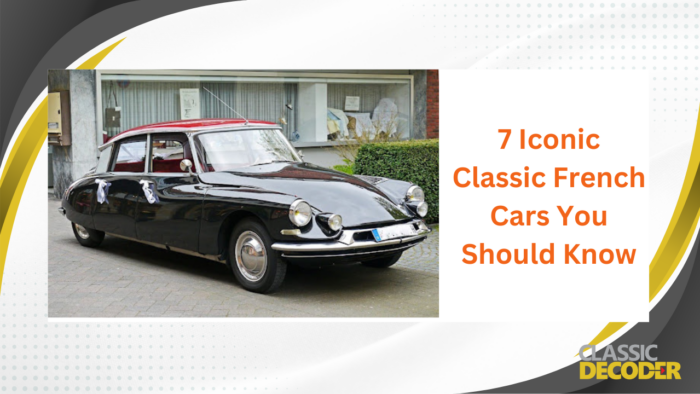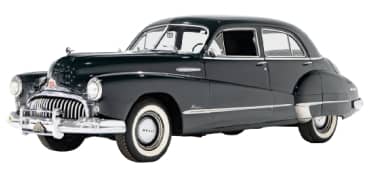For decades, French classic cars have been adding brilliance to the automotive world. Though they might have a reputation for unreliability and electrical issues, these seven classic French cars have been characterized by charisma, innovation, and beauty appeal.
Before buying a Frech classic car, you should verify if the vehicle information is correct by using accurate classic VIN decoding. You can also get the classic vehicle build sheet by VIN number to deeply understand the car’s build features, such as the engine, suspension, paint colors, transmission and more.
Classic French Cars: Old Vehicles From France
The automotive world has enjoyed great additions with these popular classic cars from France.
1. Citroen DS
One of the most beautiful and famous car models, the Citroen DS, came to the market in 1955 and was produced with modern technology. Presented at the 1955 Paris Motor Show, it was designed by Flaminio Bertoni, an Italian sculptor and industrial designer, with the collaboration of French aeronautical engineer André Lefèbvre.
The DS employed hydropneumatic suspension, and it was among the best in the market because it offered a stylish and smooth ride. First, it ran on a 1.9-liter inline-four engine, which should have approximately 75 horsepower.
Additional derivatives gave power ratings of up to 2. 3 liters, but they are more efficient than, for example, a single-lever narrow-jet spray tap. As a luxury car of its time, it was equipped with special features such as power steering, disc brakes, and a semi-automatic gearbox.
2. Renault Twingo
The Renault Twingo was first introduced in the market in 1992. It is a super-mini car mainly designed for use in urban areas. The cute and distinctively shaped look of cars was created by the company’s designer, Patrick Le Quément, who tried to combine the car’s functionality and a playful aesthetic.
Thus, it was marketed to the young, first-time car owners and people in large cities who were in search of simple, affordable, and practical transportation means in the form of the Twingo. The old Twingo model had several incredible characteristics. It was a subcompact car with a 1.2-liter inline-four engine, which produced approximately 55 horsepower. It may not have been very powerful, but the Twingo was light and small.
The Twingo version eventually proves useful in navigating busy streets, especially in the city. Still, there was sufficient space in terms of interior dimensions, and the rear-seat sliding option was an added bonus.
3. Citroën Traction Avant
The Citroën Traction Avant, which premiered in showrooms in the fall of 1934, was an innovative automobile widely regarded as one of the first to boast front-wheel drive and a unitary body. This was achieved mainly by André Lefèbvre and Flaminio Bertoni, whose ideas revolutionized the automotive industry’s design and art.
Traction Avant was initially equipped with a 1.3-liter inline-four-cylinder motor, while higher tunes offered 2.9 liters. Depending on specific models, these engines delivered between 32 and 77 horsepower.
The new car also featured a front-wheel drive system for better and more stable road holding and a low-profile body, which lowered the moment of inertia.
4. Peugeot 205
The Peugeot 205 was made in 1983 and is considered the car that brought the company back to life. Launched in place of the ill-fated 205 Prestige, it was designed by Gerard Welter with input from Paul Bracq for the interior stylings.
The 205 was available with different engines, defaulting a 954cc inline-four up to a 1. 9-liter inline four-cylinder engine in the high-performance model referred to as GTI.
Notably, the perspectives from GTI models, especially the 1.9 GTI, are renowned for their lively characteristics and generating up to 130hp. This fascinating car’s responsive handling mechanism and solid construction made it a dream tool for driving enthusiasts.
5. Citroën 2CV
The Citroèn 2CV, or ‘Deux Chevaux’ in French, was launched in 1948 for rural French peasants needing cheap and efficient transport. Designed by Pierre-Jules Boulanger, it was also characterized by a simplistic architectural form heightened by a corrugated metal exterior and spare mechanical construction.
The 2CV was powered by a range of small air-cooled two-cylinder engines, ranging from 9 horsepower for a 375cc model to 28 horsepower for a 435cc unit. In the later models, it went as high as 602cc, with power outputs reaching 29 horsepower at most.
More than this, the 2CV was low in power but had a light construction and style, and its suspension made it possible to maneuver through rough terrain.
6. Renault Espace 1
The Renault Espace, launched in 1984, is one of the few vehicles truly referred to as the first official minivan of the modern age. Laid out by Philippe Guédon, the Espace boasted a huge, highly configurable interior and an exclusive mono-box silhouette.
It was primarily intended for use by families as a general-purpose vehicle with sufficient seating capacity and storage room. The first generation provided a series of engines, including a 2.0-liter inline-four and a 2.1-liter diesel engine. Power ranged from 88 to 120hp.
The car sets new standards for usefulness as a family vehicle with its innovative use of space and individually adjustable, foldable, and removable seats.
7. Peugeot 504
The Peugeot 504, first produced in early 1968, is a mid-scale sedan designed by Aldo Brovarone of Pininfarina, and it’s famous for its reliability and comfortable interior. The car was. Its external features and reliable structure were so well-styled that it won Car of the Year in Europe in 1969.
Depending on its model and production year the 504 was offered with a range of engines to engine options. including 1.8-liter and 2.0-liter inline-four engines, as well as a 2.7-liter V6 in later models. Diesel versions were also available for sale, although these were in demand in some markets, demanding fuel efficiency and reliability.
These factors include the fact that the 504 was easy to operate and maneuver, contributing largely to its wide acceptance in the market.
All these French vintage cars had their own innovations and characteristics, and they were considered outstanding and excellent cars from their period.
READ ALSO: Top 10 Classic German Cars Every Enthusiast Should Know
Frequently Asked Questions
What is the best classic French sports car?
Arguably, the DS is the most iconic French car ever created. When it launched in 1955, it looked more like a spacecraft than a car. The Citroen DS 21 100 PS claimed a top speed of 185 km/h / 115 mph.
Is the Citroen SM a high-performance car?
Yes. The Citroën SM is a high-performance coupé produced from 1970 to 1975. The SM placed third in the 1971 European Car of the Year contest.
How reliable are cars from Germany?
They aren’t the fastest or most exciting, but they are reliable, last forever with proper maintenance, get pretty good MPG, and are reasonably affordable to buy and maintain. Some of the best DE classic cars include brands like Mercedes Benz, Porsche, Maserati, and BMW.

